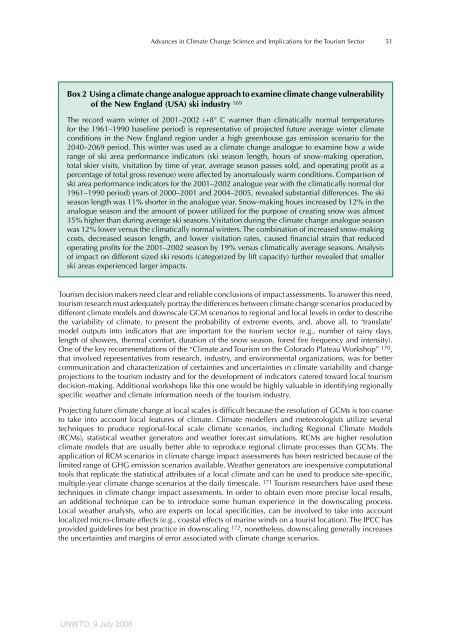Climate Change and Tourism - UNEP - Division of Technology ...
Climate Change and Tourism - UNEP - Division of Technology ...
Climate Change and Tourism - UNEP - Division of Technology ...
Create successful ePaper yourself
Turn your PDF publications into a flip-book with our unique Google optimized e-Paper software.
UNWTO, 9 July 2008<br />
Advances in <strong>Climate</strong> <strong>Change</strong> Science <strong>and</strong> Implications for the <strong>Tourism</strong> Sector<br />
Box 2 Using a climate change analogue approach to examine climate change vulnerability<br />
<strong>of</strong> the New Engl<strong>and</strong> (USA) ski industry 169<br />
The record warm winter <strong>of</strong> 2001–2002 (+8° C warmer than climatically normal temperatures<br />
for the 1961–1990 baseline period) is representative <strong>of</strong> projected future average winter climate<br />
conditions in the New Engl<strong>and</strong> region under a high greenhouse gas emission scenario for the<br />
2040–2069 period. This winter was used as a climate change analogue to examine how a wide<br />
range <strong>of</strong> ski area performance indicators (ski season length, hours <strong>of</strong> snow-making operation,<br />
total skier visits, visitation by time <strong>of</strong> year, average season passes sold, <strong>and</strong> operating pr<strong>of</strong>it as a<br />
percentage <strong>of</strong> total gross revenue) were affected by anomalously warm conditions. Comparison <strong>of</strong><br />
ski area performance indicators for the 2001–2002 analogue year with the climatically normal (for<br />
1961–1990 period) years <strong>of</strong> 2000–2001 <strong>and</strong> 2004–2005, revealed substantial differences. The ski<br />
season length was 11% shorter in the analogue year. Snow-making hours increased by 12% in the<br />
analogue season <strong>and</strong> the amount <strong>of</strong> power utilized for the purpose <strong>of</strong> creating snow was almost<br />
35% higher than during average ski seasons. Visitation during the climate change analogue season<br />
was 12% lower versus the climatically normal winters. The combination <strong>of</strong> increased snow-making<br />
costs, decreased season length, <strong>and</strong> lower visitation rates, caused financial strain that reduced<br />
operating pr<strong>of</strong>its for the 2001–2002 season by 19% versus climatically average seasons. Analysis<br />
<strong>of</strong> impact on different sized ski resorts (categorized by lift capacity) further revealed that smaller<br />
ski areas experienced larger impacts.<br />
<strong>Tourism</strong> decision makers need clear <strong>and</strong> reliable conclusions <strong>of</strong> impact assessments. To answer this need,<br />
tourism research must adequately portray the differences between climate change scenarios produced by<br />
different climate models <strong>and</strong> downscale GCM scenarios to regional <strong>and</strong> local levels in order to describe<br />
the variability <strong>of</strong> climate, to present the probability <strong>of</strong> extreme events, <strong>and</strong>, above all, to ‘translate’<br />
model outputs into indicators that are important for the tourism sector (e.g., number <strong>of</strong> rainy days,<br />
length <strong>of</strong> showers, thermal comfort, duration <strong>of</strong> the snow season, forest fire frequency <strong>and</strong> intensity).<br />
One <strong>of</strong> the key recommendations <strong>of</strong> the “<strong>Climate</strong> <strong>and</strong> <strong>Tourism</strong> on the Colorado Plateau Workshop” 170 ,<br />
that involved representatives from research, industry, <strong>and</strong> environmental organizations, was for better<br />
communication <strong>and</strong> characterization <strong>of</strong> certainties <strong>and</strong> uncertainties in climate variability <strong>and</strong> change<br />
projections to the tourism industry <strong>and</strong> for the development <strong>of</strong> indicators catered toward local tourism<br />
decision-making. Additional workshops like this one would be highly valuable in identifying regionally<br />
specific weather <strong>and</strong> climate information needs <strong>of</strong> the tourism industry.<br />
Projecting future climate change at local scales is difficult because the resolution <strong>of</strong> GCMs is too coarse<br />
to take into account local features <strong>of</strong> climate. <strong>Climate</strong> modellers <strong>and</strong> meteorologists utilize several<br />
techniques to produce regional-local scale climate scenarios, including Regional <strong>Climate</strong> Models<br />
(RCMs), statistical weather generators <strong>and</strong> weather forecast simulations. RCMs are higher resolution<br />
climate models that are usually better able to reproduce regional climate processes than GCMs. The<br />
application <strong>of</strong> RCM scenarios in climate change impact assessments has been restricted because <strong>of</strong> the<br />
limited range <strong>of</strong> GHG emission scenarios available. Weather generators are inexpensive computational<br />
tools that replicate the statistical attributes <strong>of</strong> a local climate <strong>and</strong> can be used to produce site-specific,<br />
multiple-year climate change scenarios at the daily timescale. 171 <strong>Tourism</strong> researchers have used these<br />
techniques in climate change impact assessments. In order to obtain even more precise local results,<br />
an additional technique can be to introduce some human experience in the downscaling process.<br />
Local weather analysts, who are experts on local specificities, can be involved to take into account<br />
localized micro-climate effects (e.g., coastal effects <strong>of</strong> marine winds on a tourist location). The IPCC has<br />
provided guidelines for best practice in downscaling 172 , nonetheless, downscaling generally increases<br />
the uncertainties <strong>and</strong> margins <strong>of</strong> error associated with climate change scenarios.<br />
51

















